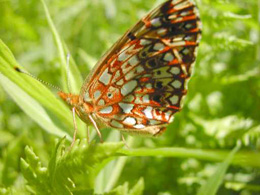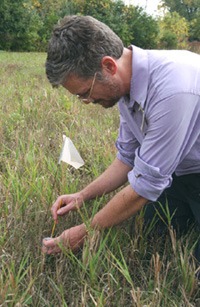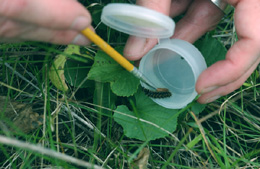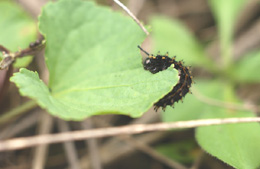 |
|
Flutterby Butterfly by Elizabeth Clements
A newest and rarest member of the Fermilab high-energy physics community is not a scientist and probably won’t contribute anything to the Tevatron’s success — except by adding beauty to the site. The new addition flies, but it is not a neutrino, and we hope it won’t head north toward Minnesota — or south toward Florida, for that matter. Not a scientist, not a particle ...but a butterfly. On October 2, Doug Taron, the Curator of Biology at Chicago’s Peggy Notebaert Nature Museum, released 40 Silver-bordered Fritillary caterpillars into the fields to the east of the Fermilab Village, with the help of Tom Peterson, a Fermilab engineer and butterfly expert, and Bob Lootens of Fermilab’s Roads & Grounds Department. They hope that by next spring, these 40 caterpillars will grow into adult butterflies and spawn a new colony of Silver-bordered Fritillaries in the Fermilab prairie. Although not an endangered butterfly, the Silver-bordered Fritillary is extremely rare in the Illinois region. Records from the 1930’s and 40’s indicate a much higher Silver-bordered Fritillary population then. A gap in the records between the 1950’s and the 1980’s leaves Taron and other butterfly experts to speculate over the dramatic decrease in the Silver- bordered Fritillary population in Illinois. The most likely culprit is the vast land development occurring during that time, and still continuing today. Two of Taron’s goals for this project are to learn why the Silver-bordered Fritillary is such a rare butterfly,and how to increase its population in the Illinois prairie.
With a wingspan ranging from approximately one to two inches, this tawny- orange butterfly draws its name from the four rows of metallic silver spots appearing on its underside. The ideal habitat for this species is a wet meadow with an abundance of violets, where the caterpillar feeds and where the female adult butterfly lays her eggs. The key to cultivating a new colony of Silver-bordered Fritillaries is finding the perfect habitat, which Fermilab has. Taron chose Fermilab as the site to release the Silver-bordered Fritillaries because Peterson had spotted some Meadow Fritillaries on one of his butterfly monitoring walks in June 2001. Peterson, who has recorded over fifty species of butterflies at Fermilab, knew that the Meadow Fritillaries (from the same family as the Silver-bordered Fritillary but not as rare) shared the same habitat and violet host plant. A member of the Northern Illinois Butterfly Monitoring Network, Peterson knew that Taron, the network director, had been looking for a location to release a colony of Silver-bordered Fritillaries.
Lootens, Peterson and Taron settled upon the field to the east of the Village, where Peterson had spotted the Meadow Fritillaries. This site is not only a perfect habitat for the Silver-bordered Fritillary because of the abundance of violets, but also because of the surrounding power lines and railroad tracks, which limit the development and mowing of the area. “It will be interesting to see after they have been released how they disperse here on site,” Peterson said.“Years from now this area could have many Silver-bordered Fritillaries all from this one action.” For Taron, the Prairie Restoration Project at Fermilab was the perfect place to reintroduce the Silver-bordered Fritillary to Illinois.“Fermilab has a world class prairie restoration,” Taron said.“I would like to learn how to include rare species like the Silver-bordered Fritillary more routinely in prairie restorations.” After receiving a British Petroleum (bp) Leader Award for funding, and a permit from the Illinois Department of Natural Resources, Taron set out with a butterfly net for the Commonwealth Edison Prairie in Grundy County in early September to gather a group of female Silver-bordered Fritillaries. Taron confined the adult females in cages containing violets, which stimulated them to lay eggs and grow into the caterpillars that he released at Fermilab. If everything goes according to plan, the Silver- bordered Fritillaries will hibernate through the winter, form their chrysalises in the spring and grow into adult butterflies in May or June of 2003. Fermilab will be monitored for Silver-bordered Fritillaries over the next several years. Taron expects to find low numbers for the first year or two, followed by a hoped-for increase in the population. But as with any experiment, nothing is guaranteed.
“This is not something with a lot of precedent. We will not know how things are going to behave and grow,” Taron said. And recognizing that patience is a virtue when it comes to butterflies, he added, “This is not a project for the impatient.” Although many new plants have been introduced to the prairie, Lootens believes that this may be the first new animal introduced to Fermilab as part of the Prairie Restoration Project. Lootens regards this groundbreaking introduction of a species as bringing the Prairie Restoration Project one step closer to being complete.
“Every part of the ecosystem is a building block. Any time that you can put a building block back in nature, it makes it more whole,” Lootens said. “As the ecosystem heals, we expect more [animals ] to come in such as the Sandhill Crane. We hope that they find us.” Taron echoed the sense of completion. “Every piece of the ecosystem does something,” he said.“We don’t always know what every piece does, but every piece does something. Anything that you can do to make a restoration more complete is worth doing.”
ON THE WEB:
|




